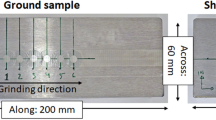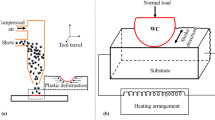Abstract
The removal of oxide scale from a hot-rolled strip surface can completely eliminate environmental pollution if performed by hydrogen-reduction descaling instead of traditional pickling descaling. However, a large number of cracks appear on the surface of a leveled hot-rolled steel strip after hydrogen reduction. This effect is likely to impede the application of reduction descaling to cold-rolled products. Nevertheless, there are almost no cracks on the surface of an unleveled hot-rolled steel strip if the hot-rolled steel strip is not subjected to repeated bending by the leveler machine. The surface quality of a reduced steel strip will be better than that of a pickled steel strip. To investigate the evolution of the surface morphologies, microstructures, and properties of an unleveled strip steel during cold rolling, unleveled strip steel samples were rolled using a four-high mill after hydrogen reduction and after pickling. The surface morphologies and cross-sectional microstructures of the samples were observed by SEM, and the surface-roughness values were measured using a TR200 profilometer before and after cold-rolling deformation. The evolution of the surface morphologies and cross-sectional microstructures of the sample after cold rolling were analyzed. The results show that the oxide scale formed on the surface turns into a metallic iron layer, and a decarburization layer appears between the metallic iron layer and the steel matrix after hydrogen reduction. Few cracks, besides pores, and bubbles, appeared on the surface of the sample after hydrogen reduction. The pores and bubbles were roll-flattened after five passes of cold rolling. The work hardening degree and mechanical properties of the reduced sample are similar to those of the pickled sample after cold rolling. Compared with the rolled sample after pickling, the surface qualities of the reduced samples are better than those of the pickled samples and better than those of the reduced samples that were subjected to leveling prior to reduction.















Similar content being viewed by others
References
1. M. Regel-Rosocka: Hazard. Mater, 2010, vol 177(1-3), pp.57-69.
2. V.M. Fainshtein: Metallurgist, 1968, vol. 12(9), pp.483-486.
N. Tan, and J. Li: Steel Rolling (in Chinese), 2014, vol. 31(1), pp.47-50.
4. R M. Hudson: Metal Finishing, 1985, vol. 83(11), pp.73-80.
5. R.M. Hudson: Metal Finishing, 1985, vol. 83(12), pp.59-61.
6. N.L. Samways: Iron & steel maker, 2001, vol 28(11), pp.23-26.
7. J. Shi, D.R. Wang, Y,D, He., H.B. Qi, and G. Wei.: Mater. Lett., 2008, vol. 62(20), pp.3500-3502.
8. A. Primavera, S. Cattarino, and M. Pavliceic: Ironmaking and Steelmaking, 2007, vol 34(4), pp.290-294.
I. Saeki, T. Ikeda, Ohno, K., T. Sato, and S. Kurosawa: Tetsu-to-Hagane(in Japan), 2011, vol. 97(1), pp.12-8
10. C. Guan, J. Li, N. Tan, Y.Q. He, and S.G. Zhang: Hydrogen Energy, 2014, vol. 39(27), pp.15116-15124.
Y.J. Yu, S.L. Li, Y.A. Jing, and Y. Han: Steel rolling (in Chinese), 2012, vol. 29(5), pp. 18-21
12. Y.A. Jing, X.M. Zang, Q.Y. Shang, Y. Qin, Y.H. LI, and B. Song.: Materials Processing Technology, 2015, vol. 219, pp.303-313.
Y.A. Jing, Y.J. Yu, and S.L. Li: Hot Working Technology (in Chinese), 2013, vol. 42(18), pp.45-48
W.H. Sun, A.K. Tieu, Z.Y. Jiang, C. Lu, and H.T Zhu: Mater. Process, 2003, vol. 140(1-3), pp.76-83
15. N. Takahira, T. Tanaka, S. Hara,and J. Lee: Mater.Trans, 2005, vol. 46(12), pp.3008-3014.
16. E.T. Turkdogan, and J.V. Vinters: Mater.Trans, 1972, vol. 3(6), pp.1561-1574.
17. F. E. Purkert: Heat Treating, 1982, vol 2, no. 3, pp. 225-231.
18. B.J. Goode, R.D. Jones, and J.N. Howells: Ironmaking and Steelmaking, 1996, vol. 23(2), pp. 164-170.
19. R Ahmed, M.P.F. Sutcliffe: Wear, 2000, vol. 244(1-2), pp. 60-70.
Acknowledgment
This project was supported by the National Natural Science Foundation of China through Grant Number 51174250.
Author information
Authors and Affiliations
Corresponding author
Additional information
Manuscript submitted May 7, 2015.
Rights and permissions
About this article
Cite this article
Jing, YA., Shang, Q., Zang, X. et al. The Evolution of the Surface Morphologies and Microstructures of an Unleveled Hot-Rolled Steel Strip During Cold Rolling After Hydrogen Reduction. Metall Mater Trans A 47, 424–435 (2016). https://doi.org/10.1007/s11661-015-3212-x
Published:
Issue Date:
DOI: https://doi.org/10.1007/s11661-015-3212-x




